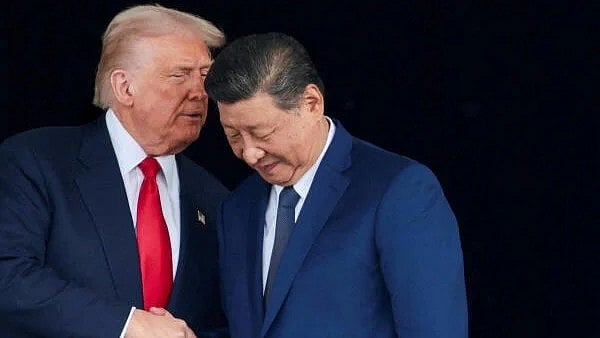
US President Donald Trump (L) and Chinese President Xi Jinping.
Credit: Reuters Photo
US President Donald Trump has returned from his trip to East Asia, where, among other leaders, he met President Xi Jinping of China. With his characteristic fondness for hyperbole, he awarded himself a score of 12 out of 10 in grading the supposed success of his meeting with Xi. The actual results, however, are far more prosaic. At best, Trump has reached a truce with Xi in the trade war that he initiated.
At the outset, it is worthwhile summarising what his meeting with Xi has accomplished. China has agreed, for a year, to sell the United States rare earths used in a host of manufacturing processes ranging from automobiles to fighter aircraft. This agreement provides significant segments of the American industry with a temporary reprieve but not a long-term solution.
China has also agreed to buy US-produced soyabeans. This, too, will offer much-needed relief for American farmers, especially across the Midwest, which produces the bulk of the country’s soyabeans. However, it should be underscored that this merely returns trade in this agricultural sector to the status quo. Even though Trump has hailed it as a breakthrough, it is nothing of the sort.
Trump has also highlighted the China’s willingness to crack down on the illegal export of precursor chemicals used in the manufacture of fentanyl, a highly addictive drug. Over the past couple of decades, the drug has led to widespread abuse across significant swathes of the United States, resulting in countless deaths. Most of these overdoses occurred in states that had witnessed sweeping deindustrialisation and subsequent job losses. Faced with bleak prospects and depression, many young men and women turned to this cheap and accessible drug. These regions are also those that voted for Trump. Consequently, he can claim that the limits he has apparently helped place on the export of precursor chemicals will help address a drug crisis that has become endemic to parts of the country.
To incentivise Xi, Trump has agreed to halve fentanyl-related tariffs from 20 to 10 per cent. The announced reductions will now bring overall US tariffs on Chinese goods down from 57 to 47 per cent. The Chinese Commerce Ministry has also announced that the two sides have agreed to a one-year extension of the truce, which was set to expire on November 10 this year.
Trump, in turn, has made other concessions. He has agreed to place in abeyance for a year his recent plans to extend technology-related export controls to subsidiaries of Chinese companies. Furthermore, the two sides have agreed to hold further trade talks in an attempt to reach a comprehensive trade agreement before he visits China again later this year. This accord, however, is fraught with peril: if they fail to do so, both parties could once again resort to highly punitive tariffs.
China appears to have made one notable political concession laden with symbolism. In the joint statement issued after the meeting, there was no mention of Taiwan, which Beijing considers a rogue province. The absence of any reference to Taiwan was clearly a nod to the sentiments of various China hawks in the Trump administration. That said, it would be naïve to assume that the PRC has abandoned its irredentist claim on Taiwan. The gesture, at best, was a tactical move on Beijing’s part.
It is also worth mentioning that the two sides agreed to work together to end the war in Ukraine. Beyond this pious declaration, no further details have emerged about how they might achieve this. As both presidents return home, they can claim victories before their domestic audiences. Nevertheless, it should be emphasised that what they have achieved amounts to a temporary reset in bilateral relations. The atmospherics of this meeting were certainly positive, and some limited progress has been made in cooling tensions.
However, it would be a mistake to conclude that the Sino-American rivalry is about to end. The two sides have deep differences across a range of issues — from competition in various parts of the world and their respective ties to Russia, to their differing views on the trans-Atlantic alliance (strained under Trump in his second term) and America’s partners across Asia. Indeed, Beijing can be none too happy that Trump, for no apparent reason, announced his intention to resume nuclear testing — especially since he made the announcement just before landing in Busan, South Korea. What signal he intended to send with this declaration, and to whom, remains an open question.
The Trump-Xi rapprochement, though limited, is of understandable concern in New Delhi. In some circles, especially given the recent downturn in US-India relations, it has led to fears of possible American unreliability and abandonment. These misgivings, at least for the duration of the Trump administration, may not be entirely unfounded. However, it would be a mistake for policymakers in New Delhi to assume that the recent warmth and limited agreements between Washington and Beijing herald a return to the ill-conceived notion of a G-2, in which the two parties would forge a global condominium. The differences between the two states cannot be papered over, especially after a single meeting that was heavy on fanfare but failed to address long-standing, underlying disagreements. What was achieved involved only tactical concessions and retreats.
The strategic differences between the two great powers—one seeking to maintain its global reach and the other aspiring to attain it—remain firmly in place. Assuming otherwise would be a mistake. The task before New Delhi is clear: despite Trump’s mercurial behaviour, it should not abandon the multi-faceted partnership that has been carefully forged, nurtured and sustained over the past two decades.
(The writer is a Senior Fellow and directs the Huntington Programme on Strengthening US–India Relations at the Hoover Institution, Stanford University)